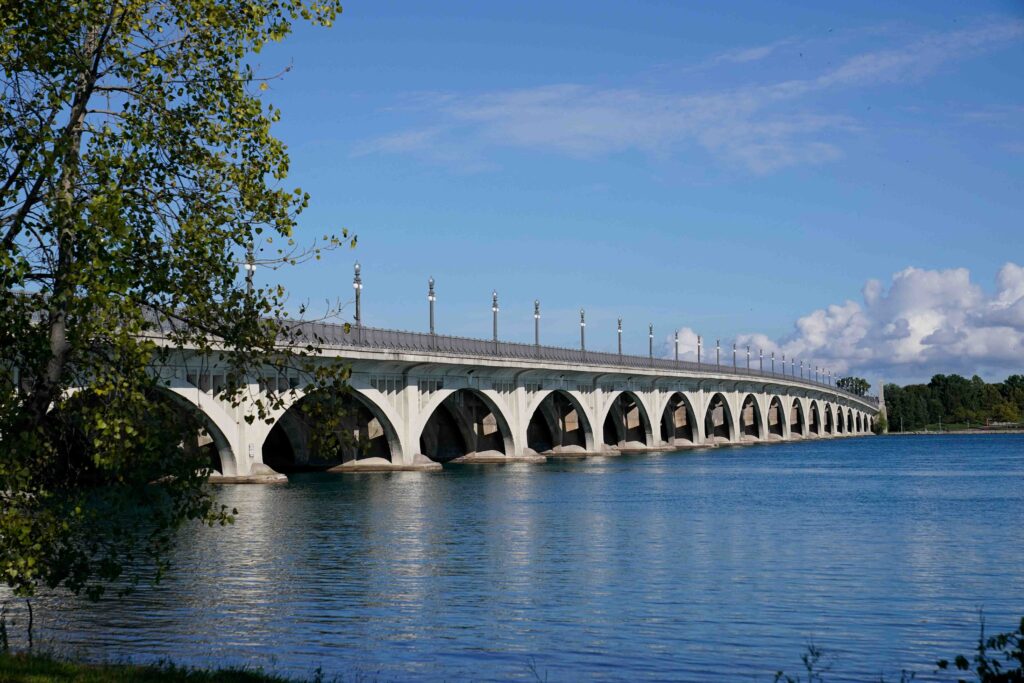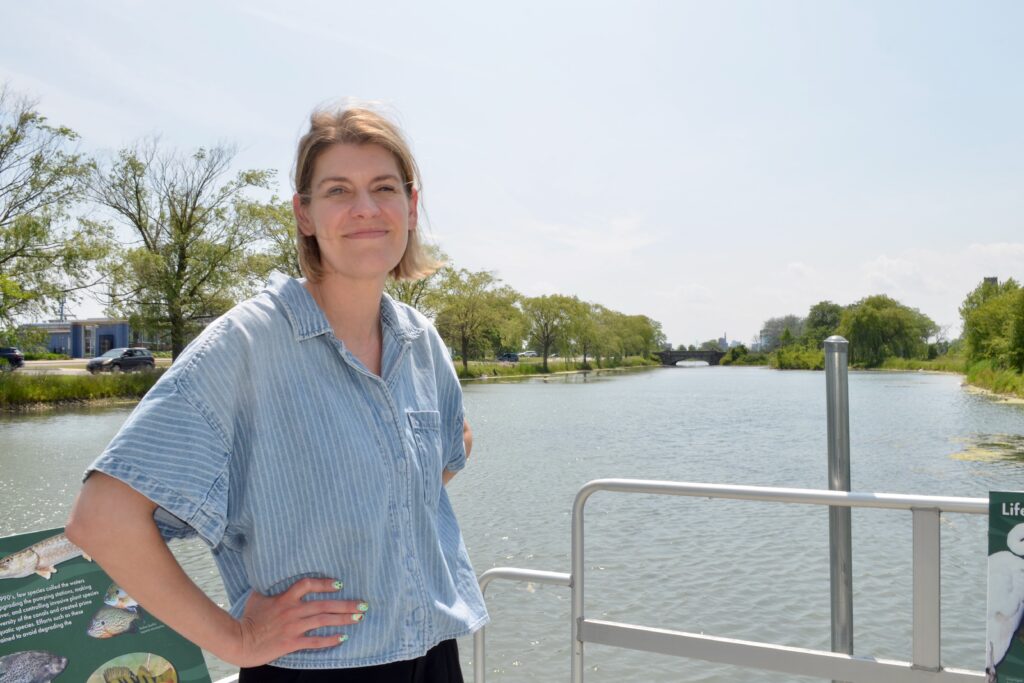Overview:
-About $144 million has been invested in Belle Isle since it became a state park, says Belle Isle Conservancy's Meagan Elliott.
-Many Detroiters say the improvements have come with tradeoffs, stricter enforcement of rules, vehicle fees, and occasional closures when the park reaches capacity.
-The Eastside Community Network's Donna Givens Davidson notes that while alcohol is allowed at the private Detroit Yacht Club, it's illegal elsewhere on Belle Isle without a permit.
This story was published as part of Next City’s Detroit News Hub, a reporting project funded by the Kresge Foundation. The hub includes BridgeDetroit, Planet Detroit and Chalkbeat Detroit.
More than a decade after the state took over management of Belle Isle, residents are being asked to help shape the island’s next chapter.
The Michigan Department of Natural Resources and the Belle Isle Conservancy have launched a survey, open through Labor Day, asking visitors to rank potential investments in the 982-acre island park. The results will guide decisions on everything from new mobility options to amenities around Belle Isle’s busiest attractions.
Since 2014, about $144 million has been invested in the park, according to conservancy President and CEO Meagan Elliott. Projects have ranged from long-delayed infrastructure repairs to new gardens and bike lanes.
“There’s been a significant amount of trust building over the last decade,” Elliott told Planet Detroit. “I’ve heard that from residents, where it’s ‘actions speak louder than words.’”
But many Detroiters say the improvements have come with tradeoffs, stricter enforcement of rules, vehicle fees, and occasional closures when the park reaches capacity. As Belle Isle enters its second decade under state management, long-simmering questions remain about access, equity, and what it means for the island to still feel like Detroit’s park.

Readers can take the DNR/Conservancy survey here through Labor Day.
From summer sleepovers to closing time: How Belle Isle access has changed
On a recent Friday morning, Dennis Miller set up for his mother’s birthday party at Sunset Point. Miller, 66, who grew up on Detroit’s east side, carries decades of Belle Isle memories, from horse rides and summer sleepovers in the 1960s to a Pershing High School reunion that once packed the island to capacity.
“They had to shut it down because of a Pershing High School reunion,” Miller recalled with a laugh. He said the last decade of improvements represents “a fabulous job.”
“I witnessed the decline of this park. I’m now witnessing the rebound of this park.”
For Donna Givens Davidson, president and CEO of the nonprofit Eastside Community Network, those same changes feel more complicated. She remembers when Detroiters camped out on Belle Isle to escape the summer heat. More recently, she’s been escorted off the island after staying past the 10 p.m. closing time.
“For almost all of my lifetime, until 10 years ago, Belle Isle was our park in Detroit. It’s ours. It’s what we have. It’s our park on the river,” Givens Davidson said.
“Was it poorly maintained? Yes. Did we need more money for it? Yes. But the way that money was given really created these control mechanisms that restricted access to people who no longer have their island park.”
MORE PLANET DETROIT REPORTING
Detroit’s Eden Park: A $21 million bet on health, wellness in polluted community
In Detroit’s 48217 ZIP code, the $21 million Eden Park Community Project aims to transform a 6-acre lot into a hub for health and wellness. The vision includes a Montessori school, community garden, amphitheater, and a secure area for Alzheimer’s patients and caretakers.
Balancing safety and community in Southwest Detroit: Lessons from Clark Park’s revitalization
In Southwest Detroit, Clark Park stands as a testament to community resilience, evolving from a site of drug activity and violence into a vibrant neighborhood hub. This transformation, driven by grassroots initiatives and city collaborations, highlights the power of community-centered policing, though it sparks debate over police roles in public spaces.
High E. coli levels at Belle Isle Beach reveal weaknesses in state’s testing program
Communication and delayed testing results kept Belle Isle Beach open despite high E. coli levels.
Belle Isle enforcement and access
Law enforcement officials say they are simply enforcing rules that have long been on the books: a 10 p.m. closing time, speed limits, and prohibitions on alcohol without a permit. But for many Detroiters, stricter enforcement has changed the island’s character.
“When the city turned over Belle Isle to the state in 2014, no rules were changed,” said Michigan State Police spokesperson Lt. Michael Shaw. “Belle Isle always closed at 10. It was not as enforced back then because of the city going through some financial difficulty and police officers being involved in other incidents. We’re just enforcing the same rules that have been on Belle Isle since I was a kid.”
Enforcement was stepped up a decade ago in response to traffic jams that sometimes left ambulances and fire trucks unable to navigate the island, as well as public drinking and marijuana use, Shaw said. “One of the first things we actually did out there was to ensure there was always a flow of traffic, so if an emergency did occur on the island, the proper services could go there.”
That shift has made Belle Isle “a lot better, safer, and cleaner,” he said, attracting more families and discouraging some of the previous behavior.
Givens Davidson said the enforcement still reflects unequal access. She noted that while Detroiters can be ticketed for drinking outdoors, members of the private Detroit Yacht Club — located on the island — are permitted to drink.
“There’s a certain level of privilege that differentiates people at the Detroit Yacht Club with people who aren’t,” she said. “It’s the exact same activity. One is criminal, one’s not.”
Lt. Damon Owens, who supervises the DNR’s law enforcement division on Belle Isle, said the Yacht Club operates under a longstanding lease and is not managed by the state. On the rest of the island, alcohol is allowed only with a formal permit.
Shaw emphasized that officers are not targeting every picnic or party.
“Are we going around checking everyone’s red Solo cups? No, we’re not doing that. We’re more concerned about the people whose fun is interfering with the family fun that’s happening on the island.”
Still, incident reports show the range of issues officers handle. Between June 22 and July 5, conservation officers responded to a self-inflicted gunshot wound, cited anglers and drivers for violations, arrested a speeding motorist with a felony warrant, and found a man in a parking lot with a blood alcohol content of 0.438%.
During the Ford Fireworks on June 23, they issued warnings for alcohol, tents, grills, and unrestrained children; that same day a child stepped on hot coals dumped in the grass, and a suspect was arrested after the theft of a pistol from a vehicle.
On July 4, officers answered domestic violence calls, put out fires sparked by hot coals, and reported a ranger being struck by a vehicle during the evening shutdown.

Belle Isle investments, improvements
When the state assumed management of Belle Isle in 2014, the first priorities were basic repairs: fixing drainage problems, reopening closed restrooms, and tackling years of deferred maintenance.
The $144 million invested in Belle Isle includes money raised by the conservancy, $23 million in federal American Rescue Plan Act funds, and contributions from the Michigan DNR, the Department of Transportation, and state police, said the Belle Isle Conservancy’s Elliott, who previously worked in Detroit’s Office of the Chief Financial Officer and as the city’s chief parks planner.
The infusion of state support freed Detroit to invest in its more than 300 neighborhood parks, many of which had fallen into disrepair during the city’s financial crisis, she said, adding that since then, more than 160 city parks have been fully renovated.
“The relationship of the state taking over the management of Belle Isle is what allowed me to focus on every neighborhood park in the city,” she said.
“I have come in with a tremendous amount of opportunity, because so many of those basics have been covered,” Elliott said of her role at the conservancy, which started July 1, 2024. With many fundamentals repaired, the conservancy can listen to what residents want for the park and advance their vision, she said.
Belle Isle mobility and the future
As basic infrastructure needs have been addressed, attention has turned to how people move around Belle Isle and what the island should look like in the years ahead.
A two-and-a-half-year mobility study found that the most visited spots are the Belle Isle Aquarium and the Anna Scripps Whitcomb Conservatory, two attractions that sit side by side. That’s where planners envision a “Belle Isle Commons,” a central square that would act as a mobility hub.
The Commons concept includes a Detroit Department of Transportation bus stop, bike and scooter rentals, air stations for tires, and expanded water and ADA-accessible features. The goal is to make Belle Isle easier to explore without relying on cars, Elliott said.
“You get in your car, you cross the MacArthur Bridge, you go to wherever your destination is, get out, do whatever you plan to do, get back in your car, and then leave,” Elliott said. “We want to create opportunities for visitors to walk, discover new things, and experience the island in a different way.”
During the mobility study, community members pushed back on a proposal to convert the one-way loop road into two-way traffic, citing Detroit’s “cruise culture” and the tradition of circling the island to take in river and skyline views.
Elliott co-chairs the Joe Louis Greenway Partnership and envisions linking Belle Isle to the city’s planned 30-mile loop of trails.
“My dream is that someone who starts out on Joy Road on the far west side can go out their front door, get on the greenway, get down to the riverfront, and get all the way to Belle Isle and enjoy their day that way,” she said.
Other possibilities include shuttles and ferries, with service connecting both sides of the island and across the river to Windsor. The next phase of community feedback on the Commons design will begin in September, Elliott said.

Belle Isle’s ongoing issues
Closures and congestion
Despite traffic management efforts, Belle Isle still reaches capacity on busy days. When the island’s roughly 3,200-vehicle limit is hit, the MacArthur Bridge is closed to cars, though cyclists and pedestrians can still enter.
Belle Isle’s capacity is monitored with a real-time traffic counter that tracks vehicles coming and going, said Tom Bissett, the DNR’s urban district supervisor who manages the island. “It’s state-of-the-art in that I can take a real-time snapshot of how many vehicles are on the island,” he said.
The DNR’s Owens, who supervises the DNR’s law enforcement division on Belle Isle, said the island was closed to vehicles four times this summer as of Aug. 12: Father’s Day (June 15), June 22, the day of the Ford Fireworks (June 23), and July 4. The closures are based on congestion levels as well as total vehicles, he said.
The DNR uses text alerts, social media, and highway message boards to notify the public, but residents say the reasoning isn’t always clear.
“If you’re shutting down the island, that means you can’t be outside here,” said the Eastside Community Network’s Givens Davidson, who noted recent island closures coincided with extreme heat.
The community activist said she hears of Detroiters using neighborhood parks more often “because they feel welcome there, and they feel as though those parks belong to them.”
She said some residents are weighing whether to hold events on Belle Isle, “because we don’t know if the island will still be open.”
Carlos Parisi, 37, a Southwest Detroit resident and owner of the food business Aunt Nee’s, said he rides across the bridge on his bike when vehicles are turned away.
“I still ride my bike right on in,” Parisi said. “I love riding my bike here and not having to deal with traffic.”
Parisi said casual riders tend to stick to the Ralph Wilson Jr. Trail, a loop around the island, while more serious cyclists use the road.
The Michigan State Police’s Shaw said some tension exists between drivers and cyclists on Belle Isle, adding that it’s common statewide and not unique to the island. He reminded motorists to leave three feet when passing and urged cyclists to obey traffic signs.
Belle Isle visitors can text the word “GEM” to 80888 or sign up online to receive alerts about closures.

Speeding on Belle Isle
Traffic safety remains a focus. On June 1, DNR officers conducted a four-hour “saturation speed patrol,” targeting motorists driving at least twice the 25 mph speed limit with increased enforcement. Officers issued 51 tickets that day, and another 20 during a similar patrol two weeks later.
“We’re going to continue to (conduct) these saturation patrols as much as we can,” Owens told the Belle Isle Park Advisory Committee in July.
Recreation passport: Lifeline or regressive fee?
Another ongoing debate: the $14 state recreation passport required for vehicles entering Belle Isle.
Some visitors, like Brooke Tiller of Farmington Hills, who helps organize the Belle Isle Swim Club, say Detroiters shouldn’t have to pay to access the park. “Do New Yorkers have to pay to go to Central Park?” she asked.
DNR staff say enforcement begins with education. Violators are given the option to mail in an envelope and purchase a pass before facing penalties. About 40% of vehicles entering Belle Isle have a passport, said Bissett, the DNR supervisor, who supports a proposed “opt-out” system that would automatically add the fee to license plate renewals.
Elliott calls the passport program a “lifeline” for state parks, noting that it funds improvements in parks statewide, including in Detroit.
In addition to funding state parks like Belle Isle, the recreation passport grant program awards about $2 million annually to local communities for park projects, according to the DNR.
Givens Davidson argues the fee falls hardest on low-income Detroiters.
“When we set fees, we don’t always understand the impact on people, and it ends up being a regressive fee, a regressive tax,” she said. She suggested income-based fee waivers and the existing opt-in model that gives Detroit residents a choice when buying vehicle registration.
For all the investments and new plans, the question of access still lingers.
“We know that good things are happening there,” said Givens Davidson, noting the Oudolf Garden that opened in 2021 as an example of progress.
“I just want Detroiters who’ve lived through the bankruptcy, who’ve lived through so many crises — I want legacy Detroiters to have not just the same access, but greater access to this resource.”





